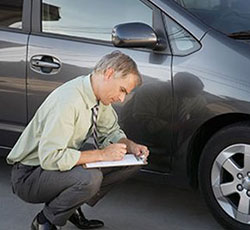On average, a single work-related motor vehicle crash can cost an employer at least $16,500. If injuries are involved, that figure can quadruple. If there’s a fatality, you could be looking at costs exceeding half a million dollars. If your employees drive as part of their job, your commitment to workplace safety extends to the vehicles they drive.
To minimize the high costs indicated above, and—more importantly—to ensure your employees are safe at all times, a proper maintenance program for company vehicles and a safe driving program are two critical components. And, your employees play a key role in the success of both programs.
What your employees need to know about fleet safety

Since your workers are the ones driving your fleet vehicles, they also serve as the eyes and ears to any problems you might not be aware of. Just like rental car companies do, you can have a check-off sheet that workers use when taking out and returning a vehicle. They can report any damage that occurs and if the vehicle is making a strange sound or running rough.
Employees should also be up front about any accidents or near misses that occur while using a company vehicle.
What your employees need to do to stay safe on the road
You also want your employees to be safe behind the wheel. Clearly state your expectations and qualifications for using a company vehicle. Also, make sure they know the repercussions for misuse. After all, employees represent your company when they travel on business.
Expectations of use should include the following:
- Follow all applicable traffic laws, including those relating to speed and distracted driving.
- Know what to do when they are involved in an accident, regardless of who is at fault.
- How to contact roadside assistance if necessary.
- Make sure the car is off, locked, and keys removed when leaving a vehicle unattended.
Also, remind your staff that you won’t compromise on rules or policies within your safe driving program. This way, drivers know that you’re very serious about their safety.
What to cover at your safety meeting on fleet safety
Discuss and demonstrate your procedures for inspecting a vehicle and how to report any trouble. If you hold the meeting in the fleet parking area, you can show them exactly how you want them to conduct the inspection that happens both when taking out a car and bringing it back. Let them know you’ll conduct random inspections of your own so they don’t ignore examining a vehicle before and after use.
Regularly review your safe driving policies. You can incorporate customized videos and other presentations to keep your staff updated on new laws as well as remind them of existing ones.
While your employees likely have been driving for many years and may have good driving records, it’s also a good idea to review rules of the road especially when new laws take effect.
For so many occupations, driving during the workday is part of the job. Getting home safely is one of their top priorities. Make sure your employees know your rules for driving on the job.
Just as important is the communication with your employees. Since you’re not usually with them on the road, you don’t know what might be happening with a vehicle, but they do. What you don’t know not only can hurt your bottom line, but also literally can hurt employees.

